Rail itinerary: Circular Explorer – Niigata and the Kansai Region
Here’s a travel route that will take you north from Tokyo to see the coastal beauty of Niigata before guiding you down to the cultural, history and food capitals of Kyoto, Nara and Osaka in the heart of Honshu. It’s a great way to experience the best of Japan while making the most of your 7-day Japan Rail Pass.
Itinerary Quick Links
Day One: Tokyo to Niigata
Day Two: Explore Niigata
Day Three: Niigata to Kyoto
Day Four: Explore Kyoto
Day Five: Kyoto to Osaka
Day Six: Explore Nara
Day Seven: Osaka to Tokyo
Day One: Tokyo to Niigata
Travel time: Approximately two hours
Route: Tokyo Station to Niigata Station via Shinkansen
Regular cost: 10,770 yen
Objective: Enjoy the charm of the port city
Niigata is often overlooked by visitors to Japan, which is a pity as the port city has much to offer in the way of scenery, story and cuisine. Niigata City, the capital of the prefecture, is a harbor town on the Sea of Japan with a population of just under one million. Established in the 16th century, the Port of Niigata was designated, in 1858, as one of just five ports in the country to conduct trade with the rest of the world.

If you catch an early train from Tokyo (the first Shinkansen leaves just after 6am, getting you there just past 8), you’ll have a full day to explore Niigata City. Here’s a model itinerary to use or adapt as you see fit.
When you arrive, drop off your luggage at your hotel. You probably won’t be able to check in before 1pm at the very earliest (it’s usually 3pm in Japan), but it’s almost always possible to leave your bags at the front desk.
Art Hotel Niigata is conveniently connected to the station, making it a popular choice for accommodation. It’s clean and modern, and consistently gets rave reviews by travelers. If you can’t get a booking there, Dormy Inn Niigata is a good bet. The rooms can be a little small, but they have all the necessary amenities, and the hotel provides an open-air bath for your first taste of Japanese bath culture (you’ll have a private bathroom too, don’t worry).

Once your baggage has been safely stowed, kick off your sightseeing with a look at the symbol of Niigata City, Bandai Bridge. You’ll be able to walk there from the station in about 15 minutes. The bridge, which is over 300m long and features six arches, crosses the Shinano River (which you can explore on a boat ride, if you feel like it). It’s lit up at night, if you’re in the mood for an after-dinner stroll.
From there, keep walking to the Toki Messe, another iconic structure. It should take you about ten minutes. When you get to the 125m-high Bandaijima Building, take the lift to the 31st floor where you can enjoy panoramic views from the (free) observation deck. You should be able to see Sado Island across the water.
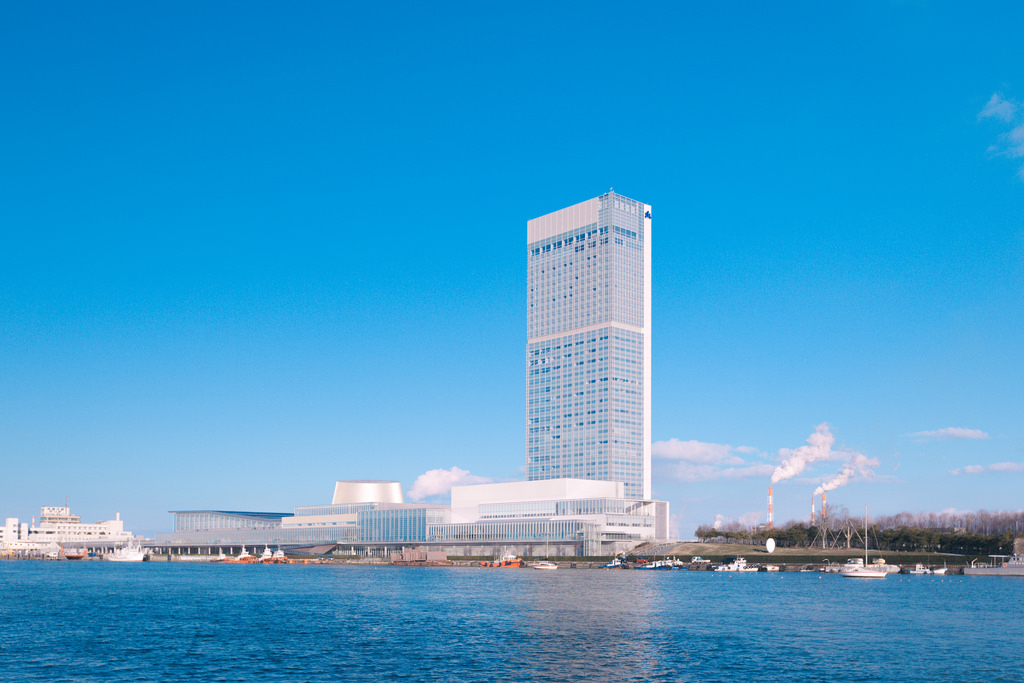
Now that you’ve surveyed your city base for the next 48 hours, it’s time to go deeper into its streets and history. Head to the Furumachi area (the central business and shopping district) either by backtracking to Bandai Bridge and crossing over, or taking a bus. Wander around the streets and alleys of this old geisha district and pop into the myriad shops. When it’s time for lunch, stop off for a plate of sushi (Niigata’s known for it) at any of the number of sushi restaurants in the area.
Next, it’s time to check out the Niigata City History Museum, which is just up the road. It was built in 1869 as a Customs House, and (much) later converted into a museum. This is the perfect place to learn all about the long, rich history of the area. Before heading back, you’ll want to walk five minutes to see Minato Inari Shrine – famous for its rotating guardian dog and site of the prayers of seafarers and their families for many years.
Once you’ve had your fill of history, take a bus back to your hotel for some downtime. When you’re ready for dinner, we recommend strolling along Higashi Odori, which is just through the Bandai Exit of JR Niigata Station, and taking your pick from the array of restaurants and pubs. You’ll find everything from ramen noodles to Thai food.
Day Two: Explore Niigata
The broader prefecture is renowned for its rice and sake, and the rurals offer wonderful hot springs and ski slopes – keep the latter in mind if you’re visiting in winter.
Before setting off from your hotel in the morning, grab breakfast at the restaurant on site. This beats wandering around the city in search of a cafe – many only open from 11am anyway. Then, we recommend embarking one of the following three sightseeing expeditions:
Go on a sake tour (there are three breweries in the city) and relax at Hakusan Park (there is a shrine to see there too) Take a ferry to Sado Island for the day (explore beaches, gold mines, tub boats and more) Visit Mt. Yahiko (for amazing views and fun in the countryside)
We’ll be focusing on the third option – a daytrip to Mt. Yahiko. Your starting point is JR Niigata Station, where you’ll need to take the JR Echigo Line for Yoshida, and then transfer to the JR Yahiko Line for Yahiko.
Travel time: Approximately two hours (round trip)
Route: Niigata Station to Yahiko Station via regular JR trains
Regular cost: 1520 yen (return ticket)
Objective: Go deep into the heart of Niigata
Yahiko is a sleepy little town with a population of under 10,000. It’s home to Niigata’s most important shrine, the original incarnation of which is said to have been built in 711. The area is also known for its hot springs and hiking trails.
Yahiko Station is unusual in that it resembles an inari shrine – so have your camera ready when you disembark from the train. Right next to the station you’ll find Yahiko Park, an expansive green space that features a little shrine and a 1000-year-old cyprus tree, among other cool things. It’s easy to spend the whole morning here, but we recommend seeing Yahiko Shrine and the mountain first, and then exploring the park if you have time left over before you catch the train back to Niigata City.
Yahiko Shrine (thought to be a power spot) is a 15-minute walk from the station. Once you’ve had a look at the shrine proper, stop by the treasure house, where you can see an old, extremely long sword. Made in 1415 and measuring 2.2m, the sword is the longest in Japan and has been designated an Important Cultural Property.
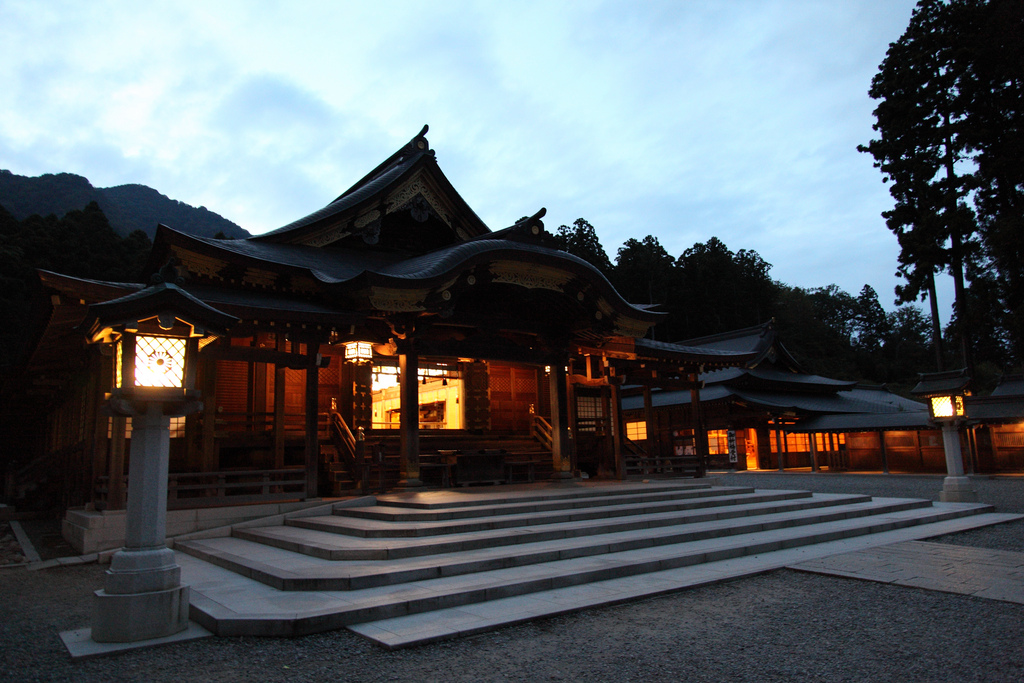
The shrine is at the base of Mt. Yahiko, which rises more than 600m into the sky. If you’re feeling energetic, you can hike to the top (it takes about two hours); otherwise, you can take the ropeway to the summit (a five-minute ride). If you’re not scared of heights, you can climb up the 100m rotating observation tower at the top to get even better views of the prefecture. Before descending the mountain, you might want to refuel with a quick lunch at the summit restaurant.
Back down in Yahiko, if you have time, you can soak your muscles in one of the several hot springs in town.
Once you’ve returned to Niigata City, we recommend ramen at Chashuya Musashi Sasaguchi for supper. It’s a local gem that’s a short walk from the station.
Day Three: Niigata to Kyoto
Travel time: Approximately 4.5 hours (including transfer time)
Route: Niigata Station to Kyoto Station (via Tokyo)
Regular cost: 22,390 yen
Objective: Begin to explore Japan’s old capital
Now that you’ve seen some of the north of the country, it’s time to head down to the Kansai region – a mellow middle place full of friendliness and fun. Since the train trip takes about half a day, we recommend getting an early start.
Before boarding the Shinkansen at Niigata Station, you’ll want to pick up an “ekiben” – a lunch box (bento) made especially for sale at train stations (eki). In Japan, each station has its own unique ekiben, and some travelers keep logs of how many different ones they’ve tried. An ekiben usually uses local ingredients and recipes. While eating on regular trains is not really the done thing, enjoying an ekiben on the shinkansen is perfectly acceptable – so tuck in!
Your destination is Kyoto – a must-see on any traveler’s bucket list. With a population of 1.5 million, Kyoto is, at the same time as being a modern hub of business and technology, a place that takes pride in its preservation of history and culture. The capital of Japan for over 1,000 years (from 794 onwards), Kyoto City is now the capital of the prefecture. Spared the bombings of World War II, Kyoto has a vast collection of original old houses, shrines and other structures that make for top-notch sightseeing.

When you pull into JR Kyoto Station, collect your bags and make your way to your hotel. Daiwa Roynet Hotel Kyoto Ekimae is just two minutes from the station and is the subject of hundreds of good reviews by other travelers. It’s a convenient spot right in the heart of Kyoto City. If you can’t secure a booking there, we recommend Hotel Mystays Kyoto Shijo as an excellent alternative. It’s five minutes from Shijo Station, and comes recommended by the Michelin Guide. If you were hoping for more traditional lodging, don’t worry – you’ll find it at the ryokan you’re booking into on Day Four.
If you’ve left Niigata early, the afternoon now stretches before you, and you could spend it in any number of ways. Some people like to wander the streets (old and new) without any goal in mind, simply taking in the centuries-old atmosphere of Kyoto, sampling the traditional sweets and keeping an eye out for geisha. The grand Buddhist temples of Higashi- and Nishi-Honganji are five minutes away.
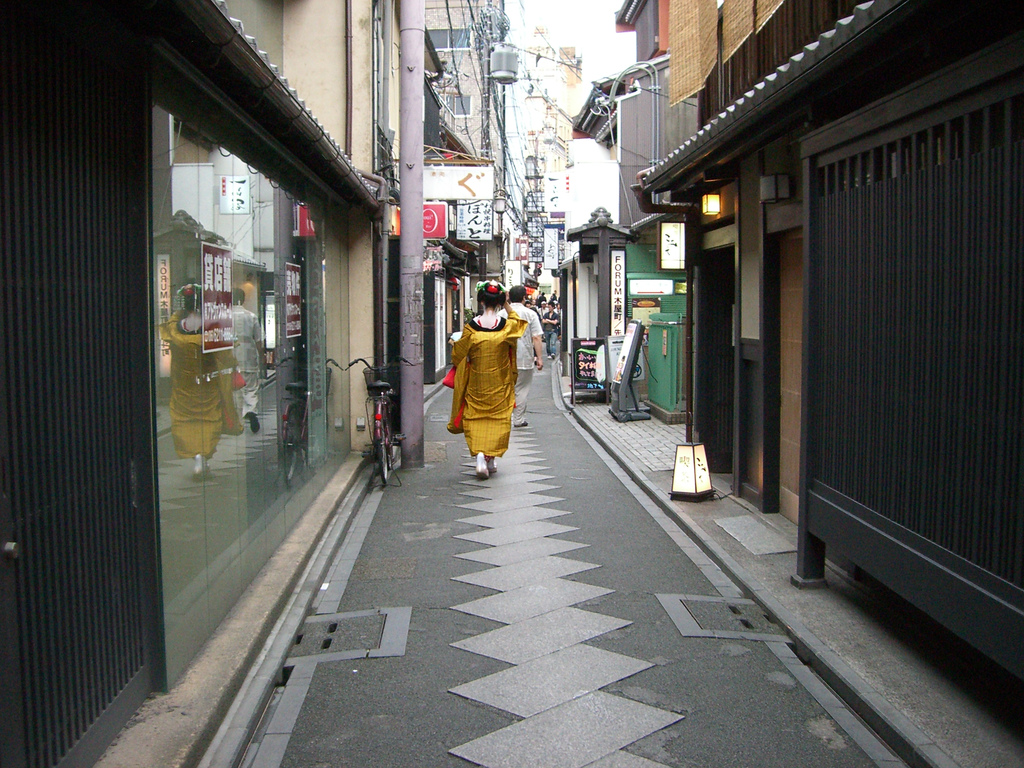
Others enjoy exploring the Isetan department store and other shops in the station buildings. There’s a museum/art gallery on the seventh floor of Isetan, and a “skyway” on the 15th. You can get better views from the station’s observation deck, though – we recommend popping up to it (look for the signs in the station) to see the city lights before retiring for the night.
If you prefer something a little more structured, we suggest the following. Start with a visit to Kyoto Imperial Palace – the residence of Japan’s Imperial Family until 1868 (when they were moved to Tokyo). The palace is surrounded by a giant park, and to reach it all you need to do is take the Karasuma Subway Line from Kyoto Station to Imadegawa Station. It’s a 10-minute ride that will set you back 260 yen.

Once you’ve had your fill of the historical buildings (you can look at them from the outside) and grounds, head back to Imadegawa Station and ride the Karasuma Subway Line back to Shijo Station (six minutes, 260 yen). Exit the station and walk five minutes to Nishiki Market – a sales hub that dates all the way back to 1310. Here you can find local specialities like pickles, sweets and fresh seafood, as well as authentic Japanese cookware. It’s a popular place for locals and tourists alike.
When your stomach tells you it’s time for dinner, the legendary dining area of Pontocho is just a stone’s throw away. It’s a vibrant alley jam-packed with restaurants (with some overlooking the Kamogawa River) – you’ll be able to feast on anything from yakitori to traditional Kyoto cooking, French food and more.
From there, it’s a short ride back to Kyoto Station on the Karasuma Subway Line – and a good rest at your hotel.
Day Four: Explore Kyoto
Objective: See the highlights of Kyoto
Yesterday you caught a glimpse of what Kyoto has to offer – now it’s time to go deeper into the prefecture. To start with, you’ll be heading to the northern part, for a visit to the zen temple Kinkakuji.
This temple is commonly known as “The Golden Pavilion”, and it’s easy to see why. Kinkakuji’s top two floors are covered in gold leaf, making for an exquisite sight – particularly when it’s reflected in the giant pond below. Originally the retirement home of a shogun, the residence was turned into a temple (as per his request) after his death.

Kinkakuji is sometimes confused with Ginkakuji – “The Silver Pavilion”, which is in the eastern part of Kyoto. While it’s not actually silver, the temple complex is beautiful and includes a moss garden and sand garden. It’s well worth a visit if you have time (though may require a bit of backtracking).
To get to Kinkakuji, board a bus from Kyoto Station (read this for more information). You’ll be there in about 40 minutes, and it will cost you 230 yen. But first – you’ll want to offload your bags. You can take them to JR Carry Service on the B1 floor of Kyoto Station, where you have the option of storing them for the day or getting them ported to your next hotel. We recommend the latter – your luggage should be there by the time you check in.
Once you’ve explored Kinkakuji, consider popping into the little tea garden that’s just outside the paid section of the temple. Here, you can sample matcha (frothy green tea) and local sweets. For an early lunch, stop by Maboya for some hearty, healthy Chinese food (served Japanese style).

After lunch, you might like to visit UNESCO World Heritage Site Kiyomizudera Temple – one of Kyoto’s most iconic places. The temple juts out over a hillside with dramatic effect. Unfortunately, it’s undergoing construction work until 2020. While you can still walk around, it’s not quite as impressive with all the scaffolding and covers in place.
You could also visit Fushima Inari Taisha – one of the most popular attractions in Japan. This shrine has thousands and thousands of torii gates (close to 32,000, to be precise), creating an almost seamless tunnel of red up the mountainside.

However, you might equally like to visit the quaint and tranquil Arashiyama area of Kyoto for the afternoon – and that’s what we’ll be focusing on here. In fact, we recommend making a night of it by booking into a traditional Japanese inn. Hotel Arashiyama Benkei is expensive, but provides a delicious multi-course dinner (here’s your chance to experience Kyoto cuisine) and a buffet breakfast. They also have natural hot spring baths. If you’re looking for something more mid-range, Hotel Ranzan is a good choice and, like Hotel Benkei, also provides the traditional experience of tatami mats and futons (unless you opt for Western-style beds). Rates include a multi-course dinner feast, and set breakfast.
To get to Arashiyama from Kinkakuji, you can either take a different bus (about an hour’s ride), or bus back to Kyoto Station and then take the JR Sagano Line to Saga-Arashiyama Station (16 minutes, 240 yen – you can use your Japan Rail Pass for this). From there, it’s a 10-minute walk to Arashiyama proper.

Arashiyama, like every other part of Kyoto, is chock full of amazing places – and even if you spent a month there, you wouldn’t be able to get to them all. Here are a few top picks to put on your to-see list for the afternoon.
A quick stroll along the main street is sufficient to see the shops and cafes; instead of getting caught up in the hubbub here, seek out Tenryu-ji Temple. This is a major temple in the Rinzai School of Buddhism, and features a stunning zen garden and pond (a great place to see the seasons reflected). If you’re all temple-d out, you can bypass this one and head straight for Arashiyama’s famous bamboo grove, access to which is just past the temple’s entrance.
After a slow meander through the towering bamboo (a real otherworldly space), we suggest making your way to Rakushisha – a thatched hut that once housed one of haiku legend Matsuo Basho’s disciples. Rustic is the word here.
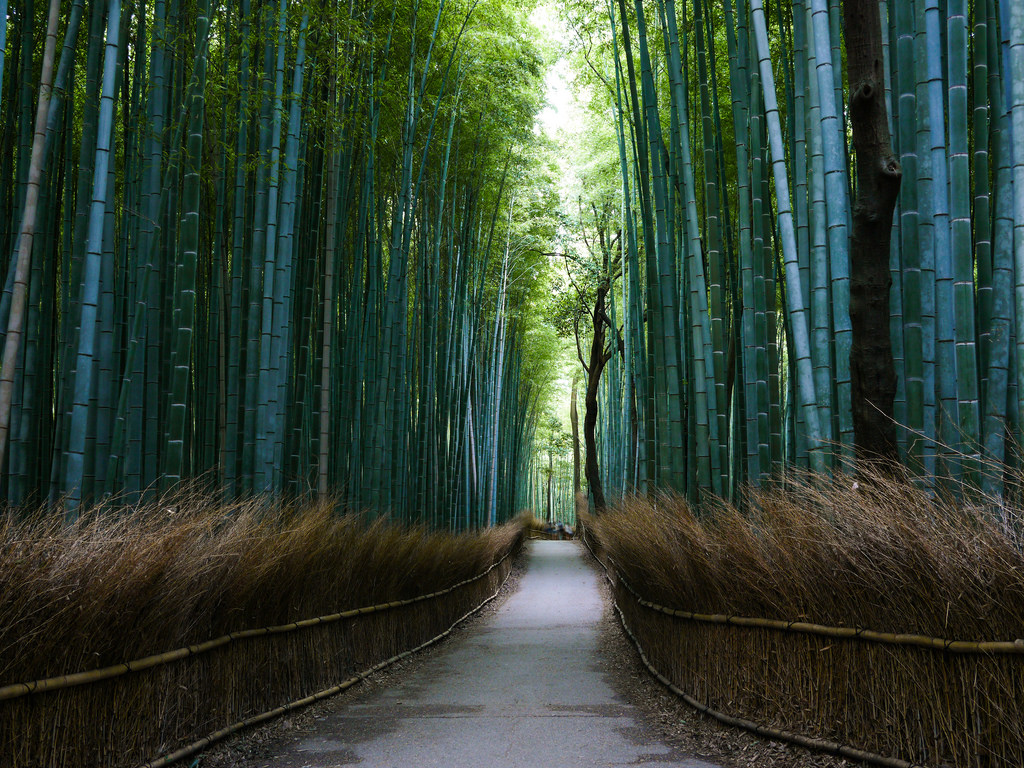
Then, you can either do some temple-hopping (there are a number of temples in the area) before you retire for the night, or take a walk along the river, stopping off at the Arashiyama Monkey Park (where monkeys roam freely) and then proceeding to a tiny, oft-overlooked temple some way down the path. Few tourists know about it.
Day Five: Kyoto to Osaka
Travel time: 30 minutes
Route: JR Kyoto Station to JR Osaka Station
Regular cost: 560 yen
Objective: Explore “Japan’s kitchen”
Today you’re traveling south from Kyoto down to Osaka, the commercial hub of the country for centuries. Geographically it’s tiny, but the prefecture is home to almost nine million people. Here, the accent is different and the atmosphere a lot more open than other parts of Japan. Osaka is known as “the nation’s kitchen” because of its delicious, diverse cuisine. This is a place to, primarily, eat, secondly, eat, and then shop and do some sightseeing.
Before doing any of the above, you’ll want to drop off your bags at your hotel, or otherwise deposit them at the “Baggage Room” on the north side of the central concourse in JR Osaka Station for later collection.
For tonight and tomorrow, we recommend booking a room at either Hotel Mystays Shin Osaka or Shin-Osaka Station Hotel (or Annex). Both are comfortable and conveniently located close to Shin-Osaka Station, making getting around Osaka, and your return trip to Tokyo, easy.
When in Osaka, there are three things you simply have to do: See the castle, feast on the Dotonbori streets, and snap a selfie in front of “The Running Man”. Let’s start with the castle. To get there, you’ll need to take the JR Osaka Loop Line from JR Osaka Station to Osakajokoen Station – it takes just under 10 minutes and is free with the rail pass.

Osaka Castle has a long history steeped in battle, making for a 3D immersion in Japan’s past. You can climb the multiple floors of the castle, looking at a wide range of artefacts and trying on some samurai armor along the way. The castle is surrounded by a park that measures over 100 hectares and features plum and cherry blossoms galore. When you’re done inside, you can wander around and enjoy the greenery, while also admiring the massive moat and stone walls.
All that history will probably make you hungry, so we recommend heading back to the station and taking the JR Osaka Loop Line to Tsuruhashi Station, then changing to the Osaka City Subway Sennichimae Line and taking it down to Namba Station (18 minutes, 180 yen with the rail pass).
A short walk from Exit 14 of Namba Station will deliver you into Dotonbori – a shopping, entertainment and eating paradise like none other. Most of the action takes place on either side of the Dotonbori Canal; you’ll walk through parallel alleys lined with neon electric signs and lanterns, where theatrical entertainment spots jostle for position with tiny souvenir shops and dozens upon dozens of eateries.

The best way to experience Dotonbori is to simply wander along the streets and see where your eyes and appetite take you. Osaka is famous for its takoyaki (deep-fried octopus dumplings) and okonomiyaki (a kind of savoury pancake), so perhaps try those and then see what other gastronomical delights you have room for.
If you walk north, you’ll find yourself in Shinsaibashi Shopping Street, which is the perfect place to do some more heavy-duty buying. Before you go there, though, be sure to snap a photo in front of the giant Glico advertisement that looks directly onto the Dotonbori Canal. “The Running Man” has been there (in one form or another) since 1935 and has come to be an unofficial symbol of Osaka.
To get back, all you need to do is take the Osaka City Subway Midosuji Line from Shinsaibashi Station to Umeda (right next to JR Osaka Station), or all the way to Shin-Osaka Station if you’re ready to call it a day.
If you have time and energy to spare, you can explore the snazzy buildings of JR Osaka Station, as well as the iconic red Hep Five shopping and entertainment center across the road – it features a rooftop ferris wheel and giant whale sculpture. The Umeda Sky Building, just north of the station, is also worth a visit. It’s an architectural feat that has a “floating garden” in the sky – and an observation deck, too. If you’re feeling peckish, the restaurants in any of these three spots will be able to serve up something to stave off starvation.
Umeda also boasts a number of pubs and other watering holes, many of which can be found simply by wandering around the narrow streets near the station. When you’re ready to go home, Shin-Osaka (and your hotel) is a four-minute ride from JR Osaka Station. It normally costs 160 yen, but is free with your rail pass.
Day Six: Explore Nara
Travel time: Two hours (round trip)
Route: JR Shin-Osaka Station to Nara Station (via JR Osaka Station)
Regular cost: 1840 yen (round trip)
Objective: Experience another side of Japanese history and culture
The Kansai region is so rich in sightseeing opportunities that it can be difficult to decide what to put on a travel itinerary. For Day Six of your trip, we recommend an excursion to Nara – the first capital of Japan from 710 to 794. Kobe, the north-shore neighbor of Osaka, is also a great place to spend the day, as is Universal Studios Japan in Osaka itself – but here we’ll be focusing on a trip to the east.
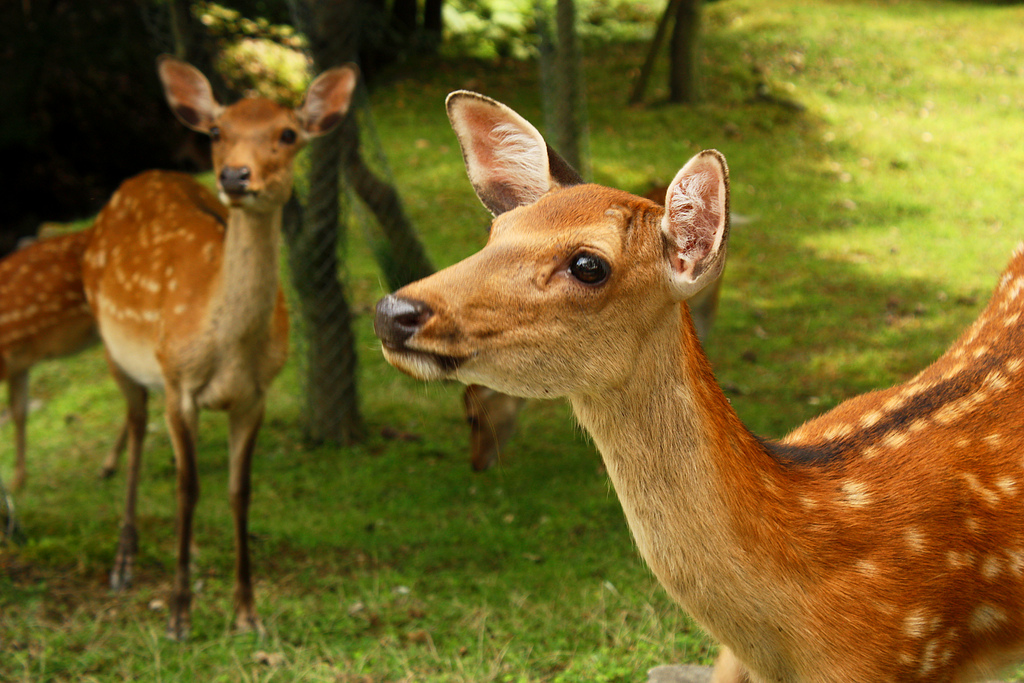
Nara is filled with beautiful temples and other historical treasures (several of which are World Heritage Sites – including the ones we’ve highlighted below), as well as herds of friendly deer that will bow to you in exchange for a special kind of rice cracker. Nara City is small enough to navigate on foot for the most part; the local buses will get tired legs to tourist attractions that fall further afield.
To get to Nara, board any JR train from Shin-Osaka to Osaka, and then transfer to the JR Yamatoji Rapid Service, which will take you to Nara Station.
Nara City is very easy to navigate; just exit the station and follow the signs for about 15-20 minutes. You’ll soon come upon Kofukuji Temple, which used to be the family temple of the powerful Fujiwara clan back in Nara’s heyday. Look out for the three- and five-storey pagodas in the temple grounds, and pop into the National Treasure Museum for a peek at awesome Buddhist art.
From there, keep going until you see a deer enclosure (a park, really) on your right – and get ready to shell out a few hundred yen for stacks of the senbei crackers they like so much. When approached by the deer, bow, and when they return the favor, hand over a cracker. Watch your fingers!

Crossing the road and passing a line of souvenir stores will take you to the world-famous Todaiji Temple, perhaps best known for its 15-m high bronze statue of Buddha. The hall in which the statue is housed has its own claim to fame as the former largest wooden building in the world. You’ll see a pillar with a hole at its base while you’re walking around; it’s said that squeezing through this will bring enlightenment in the next life – just be sure not to get stuck!
Before doing any more temple hopping, you might want to stop for lunch at Izasa on your way out of Todaiji. They serve up traditional dishes and local specialities like sushi wrapped in persimmon leaf. A viable alternative is LBK Craft, a funky craft beer bar where you can enjoy fusion food – including vegetarian and vegan options.
Once you’ve refueled, make your way to Kasuga Taisha, a grand shrine that has its own distinct style of architecture. The shrine is famous for the hundreds of lanterns that line the approach and hang from the buildings. While you’re there, be sure to check out the Kasuga Taisha Shinen Manyo Botanical Garden too, a short walk from the main complex.
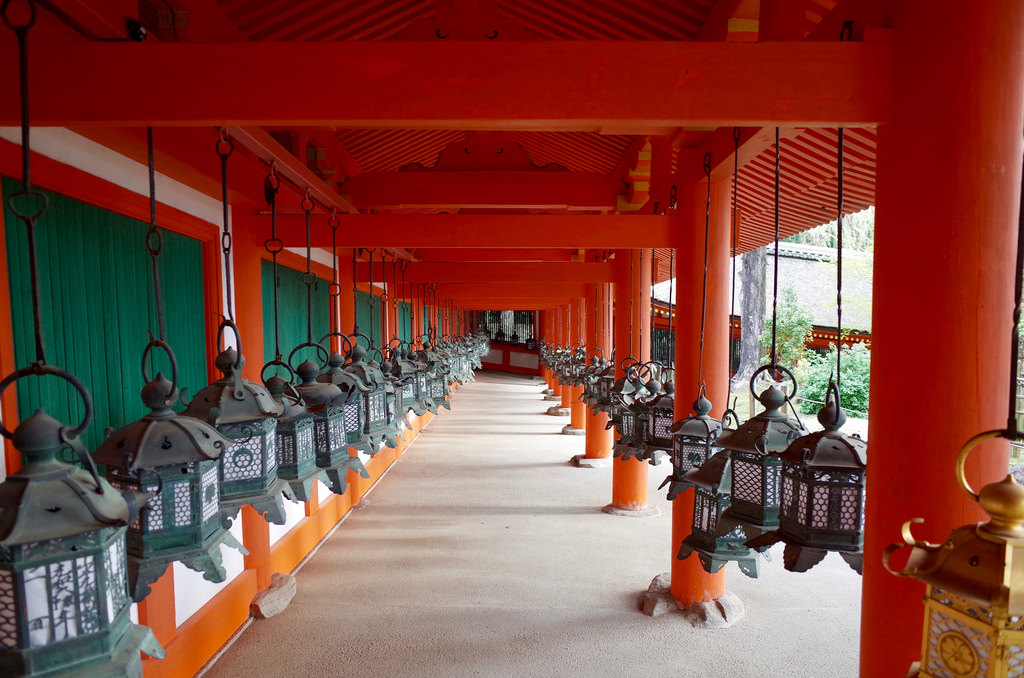
If you have any time left at the end of the afternoon, we recommend spending it in leisurely way in Nara Park before catching the train back to your hotel. For dinner, any of the restaurants in and around Osaka Station are once again a suggestion; alternatively, see what the restaurant at your hotel has to offer.
Day Seven: Osaka to Tokyo
Travel time: Approximately 2.5 hours
Route: Shin-Osaka Station to Tokyo Station
Regular cost: 14,650 yen
Objective: Return to Tokyo
If you don’t have pressing engagements in Tokyo, you might want to spend the morning in Osaka doing some last-minute shopping and wandering about. Namba Parks is good for this – a hub of 100+ stores just a stone’s throw from Namba Station. There are some nice coffee shops there too, if you feel like a lazy brunch, and a rooftop garden that’s worth a look.
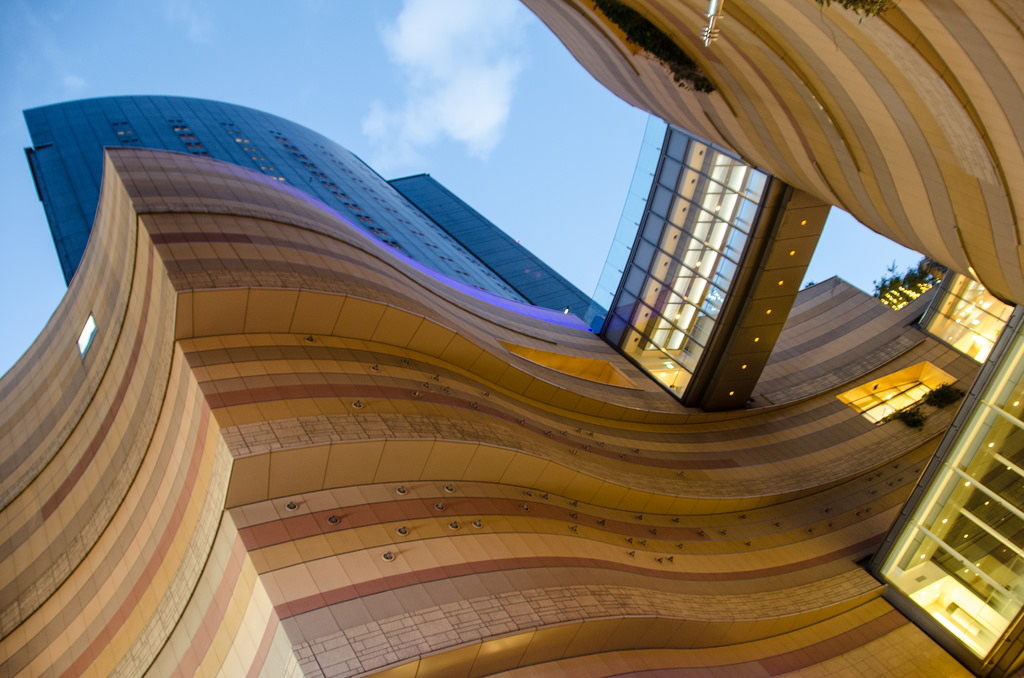
To get to Namba, take the Osaka City Midosuji Line to Namba, then walk ten minutes to the shopping complex. The cost is 280 yen, and the train ride takes about 28 minutes. There is a way to do it for free using only JR lines (and your rail pass), but that option is much more lengthy and complicated!
When you’re all shopped out, return to Shin-Osaka Station, collect your baggage (we recommend leaving it in a locker, or asking the hotel if they can hold onto it for you, before going to Namba) and board the Shinkansen back to Tokyo. Seven days well spent!
Categorised in:
This post was written by Japan Rail Tickets
